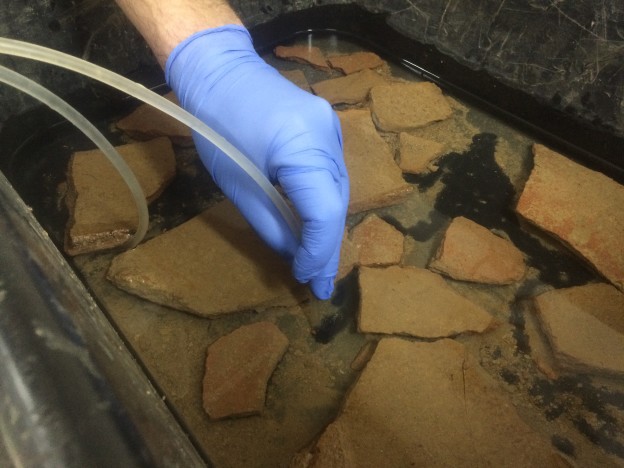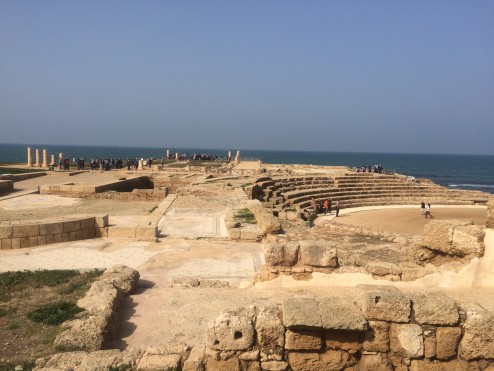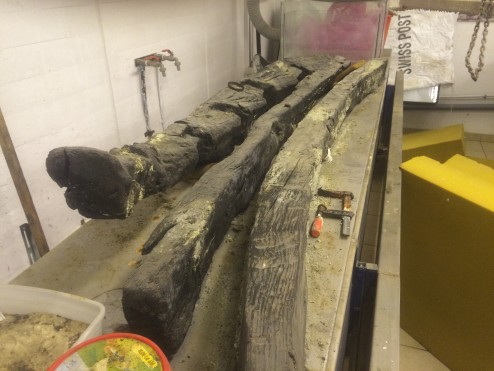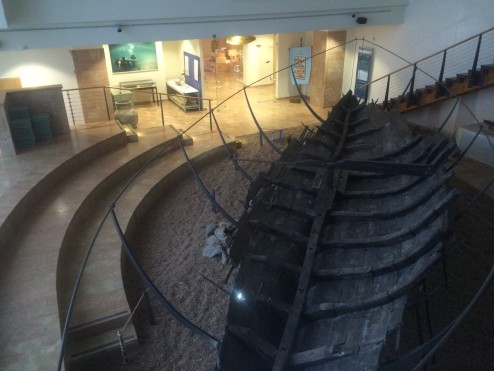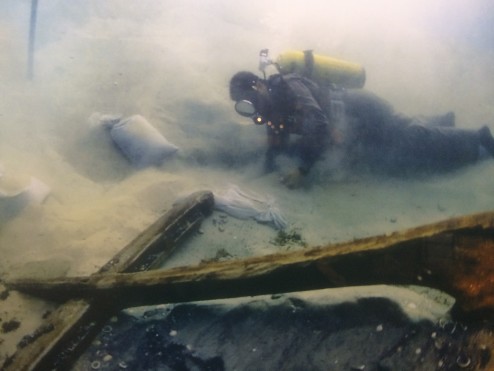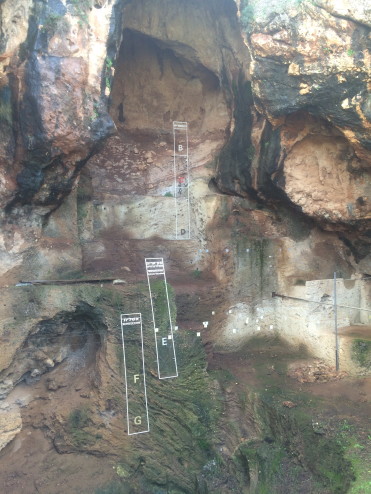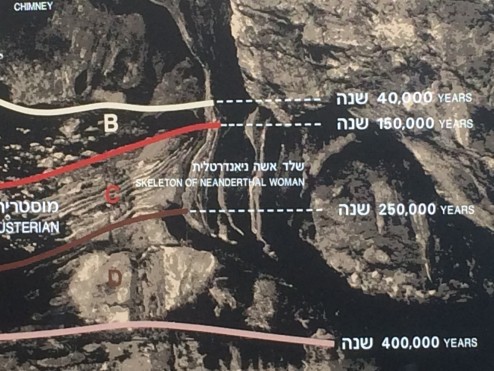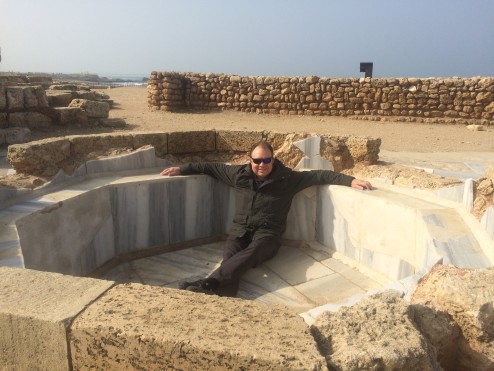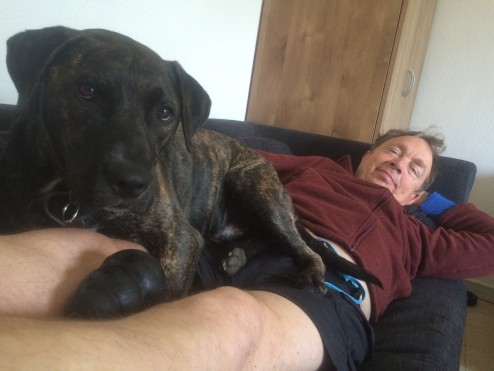In the ‘Cradle of Civilization’ we expected to see well researched antiquities from the Canaanites, through Hellenistic and Roman Periods, through the Crusades to the Fall of the Ottoman Empire. What really surprised us though is the frequent NEW findings by amateur archeologists, even in the midst of our visit to Haifa. Local spelunkers just found coins from Alexander the Great in a local Israeli cave, and amateur scuba divers unearthed a huge cache of coins just offshore from the Caesaria ruins (above, halfway between Haifa and Tel Aviv).
A wonderful museum, with displays that put these artifacts into context is the Archeological Museum at the University of Haifa. We lucked out and got our friends’ son JJ, a diver and reclamation/preservation specialist to give us a tour of his labs there, and the Museum. A Phoenician sailing ship crashed on the reef near Caesaria, and lay there protected by salt water and sand for over 2000 years. JJ and his colleagues had to bring it up without exposing it to air as it disintegrates if not immersed in polyglycolethalene solutions, until all the sea water is slowly replaced with the absorption of this waxy solution. Unfortunately, the team is stymied with recovered rope; it just doesn’t respond the same way, so the lab has tiny shreds of rope in experimental solutions for the time being.
The Phoenicians (Canaanites from 1200 BCE) were the ultimate maritime trade specialists. They were known to the Greeks and Romans as, “The Traders in Purple”; they hauled cargo in large and small loops all around the Mediterranean basin, but called western Lebanon their home, and Tyre their capital. Because archeologists recovered an intact keel, and the lower planking and cross beams, the bottom third of the original sailing ship above is on view. Not only did they painstakingly preserve an unusually designed anchor (below, exhibit photo), they made models and repeatedly dropped them in water…..to find that they always landed right side down for anchoring!
JJ’s instruction really expanded our appreciation of Caesaria and Akko, the two archeological sites we visited. We enjoyed being students again at the edge of the Sea, observing the march of civilizations before us in touchable form. I am sure I would have enjoyed that History of Western Civ class at Stanford a lot more if I could have listened to lectures in the Hippodrome and the Coral Palace at Caesaria, and the Ramparts at Akko with the ocean lapping at the ruins.
Israel not only offers the “Old and Older”, but the caves throughout the country, especially on the slopes of Mt. Carmel near Haifa, also offer hikes to caves with prehistoric remains. The Tabun Cave (above) was our favorite; turn north across the wadi to view the largest intact fully exposed fossilized reef in the world, and turn south to view limestone bell caves and a collapsed karstic cave revealing a perfect wall of civilization (above). Here, evidence was gathered that confirmed that Neanderthal and Homo Sapien Sapien coexisted in this area and controlled fire earlier than expected.
Notice I did not say “peacefully coexisted” because DNA and other evidence from other caves in Israel and a 2.5 Million year old jaw found recently in Ethiopia suggest that Homo Sapien replaced Neanderthals due to several factors: 1) Neanderthals were driven out by Homo Sapiens; 2) Homo Neanderthal females mating with Homo Sapien males produced sterile offspring so Homo Sapien is not a Neanderthal evolutionary descendant; 3) both of these forms of early human descended from the same source of DNA; 4) Neanderthals required far more calories to survive than Homo Sapien putting them at risk; 5) Neanderthals did not adjust to cooling temperatures turning the forests into grasslands, requiring new “planned” hunting techniques the collapsed chimney in the cave above was used by Homo Sapien to drive herd animals in to their death and butchering inside the cave; and 6) Neanderthals never developed sufficient tool use from rock and bone to allow them to evolve to smaller teeth in favor of tool use, and therefore derive nutrition from a greater source of nutrients.
As Steven turns 60 in two months, he feels he can’t possibly be that “old”. As his elders, we know,”being old” is just a matter of perspective. After 2.5 million years of adaptation, we learn from our predecessors, “Adapt or die”. Since Steven is the most adaptive man we’ve all ever met, we know he will “Live Long and Prosper” (R.I.P. Leonard Nimoy), and quickly learn the most important lesson of wisdom and age….GETTING OLD IS FUN IF YOU DO IT WITH THE RIGHT PEOPLE….that would be me!… and our friends and family!
Fortunately, he already knows, that a nap with a big dog in your lap extends your life more than any super vitamin package and anti-oxidant elixirs!

